- 注册
- 登录
- 小程序
- APP
- 档案号


MVRDV · 2021-03-30 09:15:43
深圳歌剧院位于深圳南岸的关键位置,毗邻连接深圳与香港的深圳湾大桥,它将成为深圳湾新兴的系列文化项目“串珠”中一枚闪耀的宝石。MVRDV将歌剧院的设计方案命名为“声浪”,利用了地块所在的显著地理位置,同时受到建筑本身功能的启发,采用具有戏剧化的折叠式屋顶,最终荣获竞赛三等奖。
Located in a critical position on Shenzhen’s southern shore and highly visible from the Shenzhen Bay Bridge connecting the city to Hong Kong, the Shenzhen Opera House will be the main jewel in a necklace of cultural projects that are emerging in Shenzhen Bay. MVRDV’s proposal for the Opera House, named The Soundwave, takes advantage of this prominent location, with a folded roofline in a dramatic form inspired by the building’s function, which won the 3rd place in the competition.
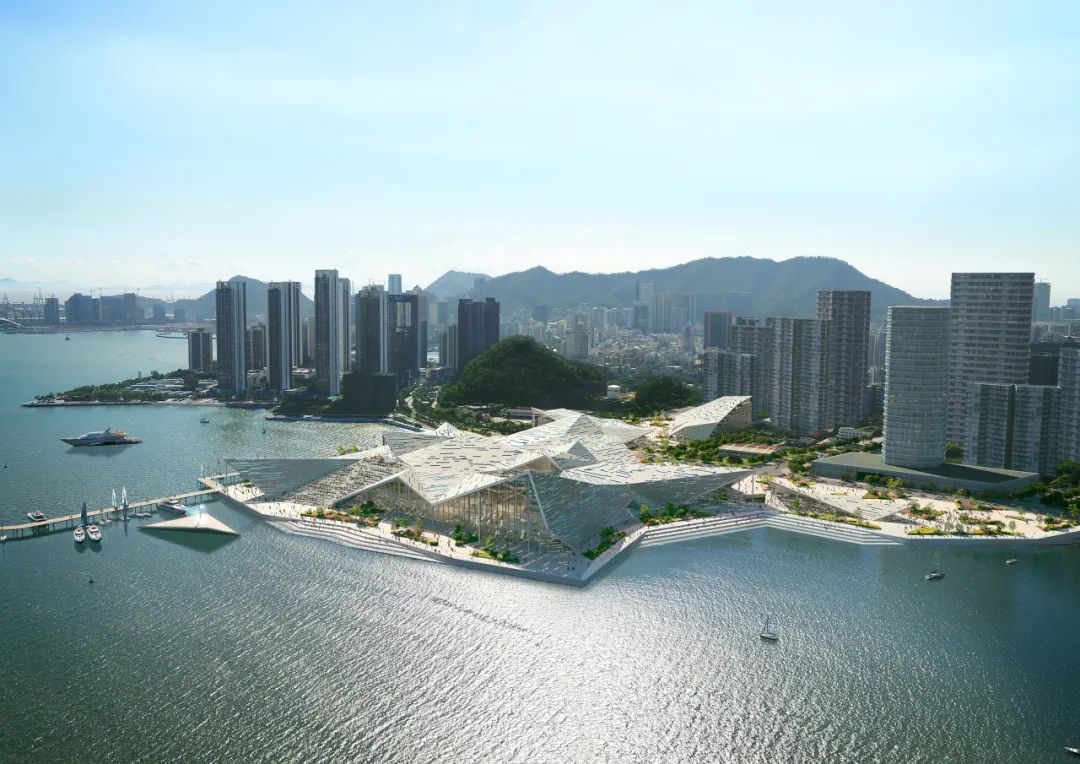
深圳歌剧院拥有四个表演厅,共5500个座位,将成为世界上最大的剧院之一。以“声浪”为名的设计概念中,四个表演厅共同被一个标志性的屋顶笼罩,屋顶通过折叠,形成入口空间,同时,折叠的形态在关键位置“抬起”,强化了特定的视野,并制造出天窗和屋顶酒吧的空间。倾斜的露台融入折叠的屋顶,提供户外的表演和观看场所。屋顶采用浅灰色的本地石材,强调了建筑形体,也帮助其更自然地融入周边的景观。
With 5,500 seats spread across four performance spaces, the Shenzhen Opera House is set to be one of the largest in the world. The Soundwave unites these four venues under a single iconic roof shape, which is folded to form entrances and “lifted” at key locations to highlight certain views and create skylights and rooftop bar spaces. Incorporated into the folds of the roof are sloping tribunes, providing outdoor seating spaces to enable open-air performances. The roof is finished in a light grey local stone to emphasise the building’s form, while also helping to integrate the building into its landscape.
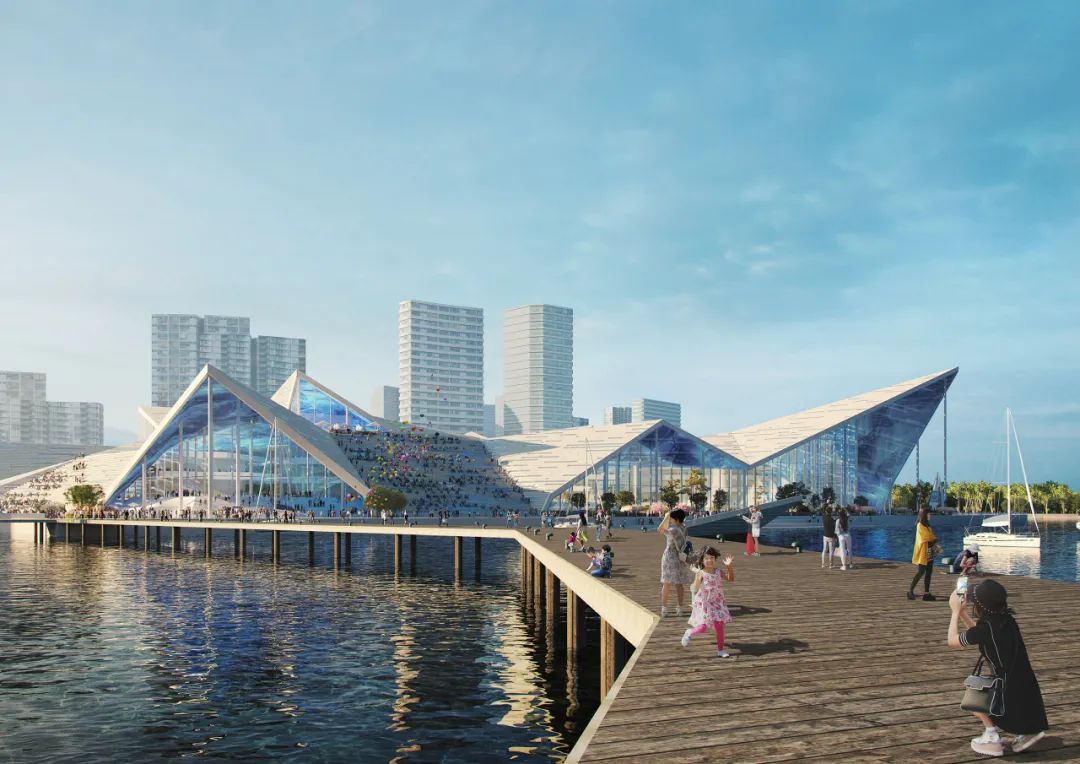
歌剧院的选址靠近望海路计划中的地铁站,这一现状直接决定了歌剧院的入口和动线顺序:游客从路面下方进入一个开阔的下沉广场,广场有一部分受到悬挑的屋顶遮蔽,可以使游人免受日晒和雨水的影响。从入口广场可以到达通向四个表演厅的大堂,从大堂另一侧的从这个入口广场,参观者继续进入覆盖所有四个场所的大大厅,并且可以立即欣赏大厅另一侧面向海湾的美景。向上看,大厅的天花板有如一块巨大的画布,可以投射各式各样的艺术光效,营造出动态变幻和充满活力的氛围。
The building is positioned directly adjacent to the location of a planned metro station on Wanghai Road, which strongly informs the building’s entrance sequence: from below the road, visitors emerge into a generous entrance plaza which is partly protected from sunlight and rain by the overhanging roof. From this entrance plaza, visitors continue into the large hall that envelopes all four venues, and can immediately appreciate the views towards the bay generated by a roof fold on the other side of the hall. Above, the ceiling of this entrance hall acts as a gigantic canvas for artistic light projections, giving the space a dynamic feeling and the building an ever-changing atmosphere.

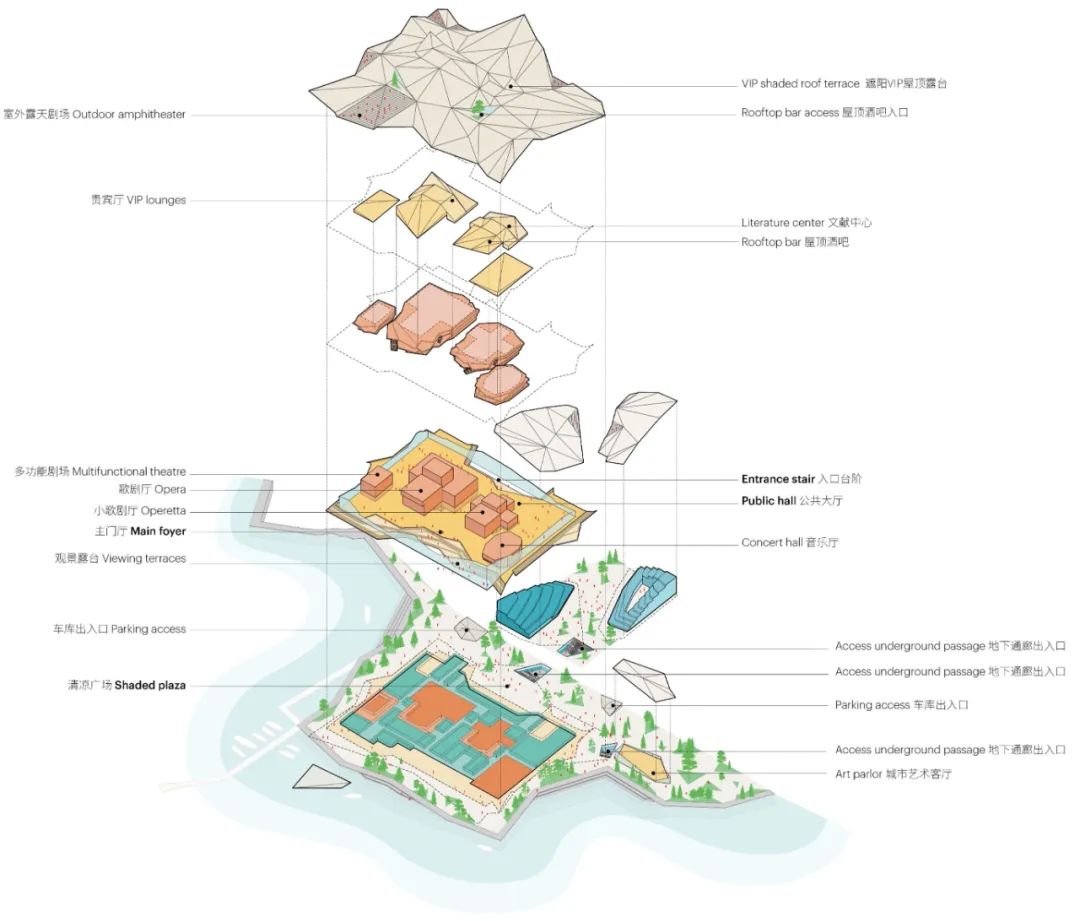
概念解析
concept diagram
和构造较为复杂的屋顶相比,歌剧院的内部空间和布局则相对简单直接。入口大厅的平面呈现为简单的巨型,四面由玻璃墙围合而成。部分后勤设施设置在大厅的下一层,通过隐藏的网络体系将四个表演厅与功能空间联系在一起,同时保持公共入口在各个方向都有着高度的连通性和可达性。
Despite the complex form of the roof, the interior space and its arrangement is deceptively simple and therefore easy to navigate. The entrance hall is a simple rectangle in plan, enclosed by the roof and the glass walls underneath it. The back-of-house facilities are partially sunken on the level below the entrance hall, connecting all venues with a hidden network of functional spaces while maintaining a public entrance that is open and permeable on all sides.
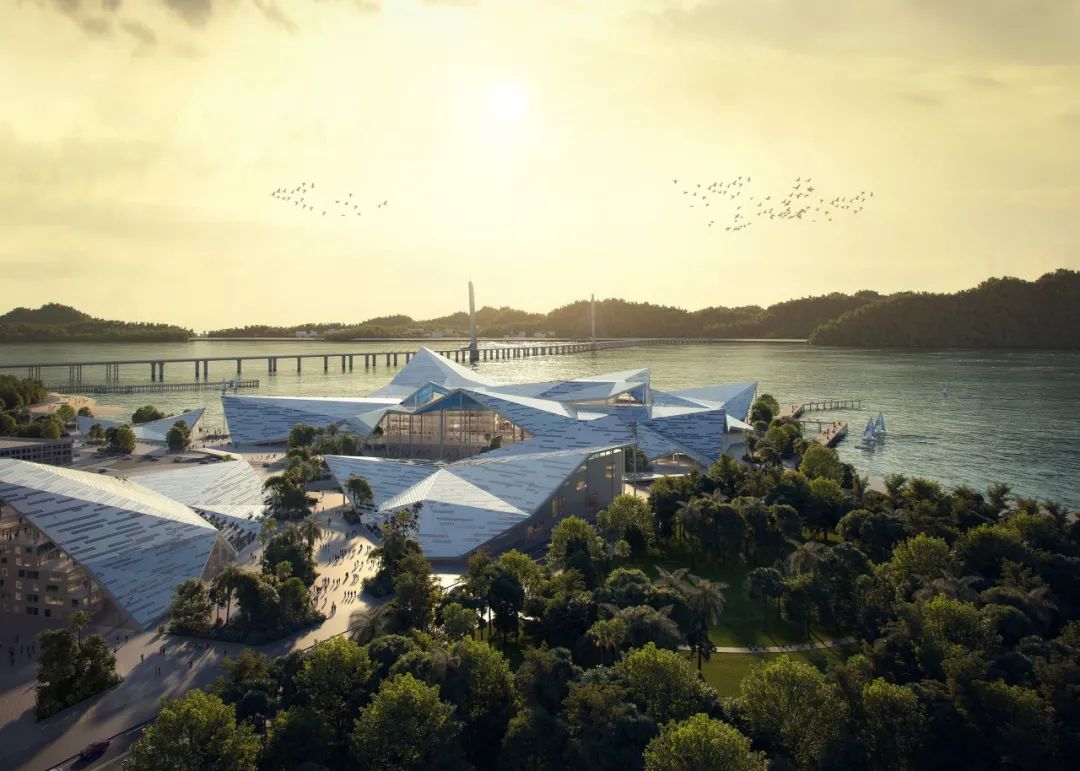
四座表演厅包括规模最大的2,300座的歌剧院、1,800座的音乐厅、800座的轻歌剧院和一个容纳了600个座位的多功能厅。每个场馆的色彩和材料都赋予了各自独特的性格,其灵感来自中国戏曲的四个主要人物:生、旦、净、丑。
The four venues comprise the main 2,300-seat opera theatre, a 1,800-seat concerthall, a smaller “operetta” space of 800 seats, and an adaptable multi-functional performance space with a capacity of around 600 seats. Each ofthe venues is given its own unique character through its colours and materials, inspired by the four main characters in traditional Chinese opera: the Sheng (male role), Dan (female role), Jing (painted face male) and Chou (the comedy role).
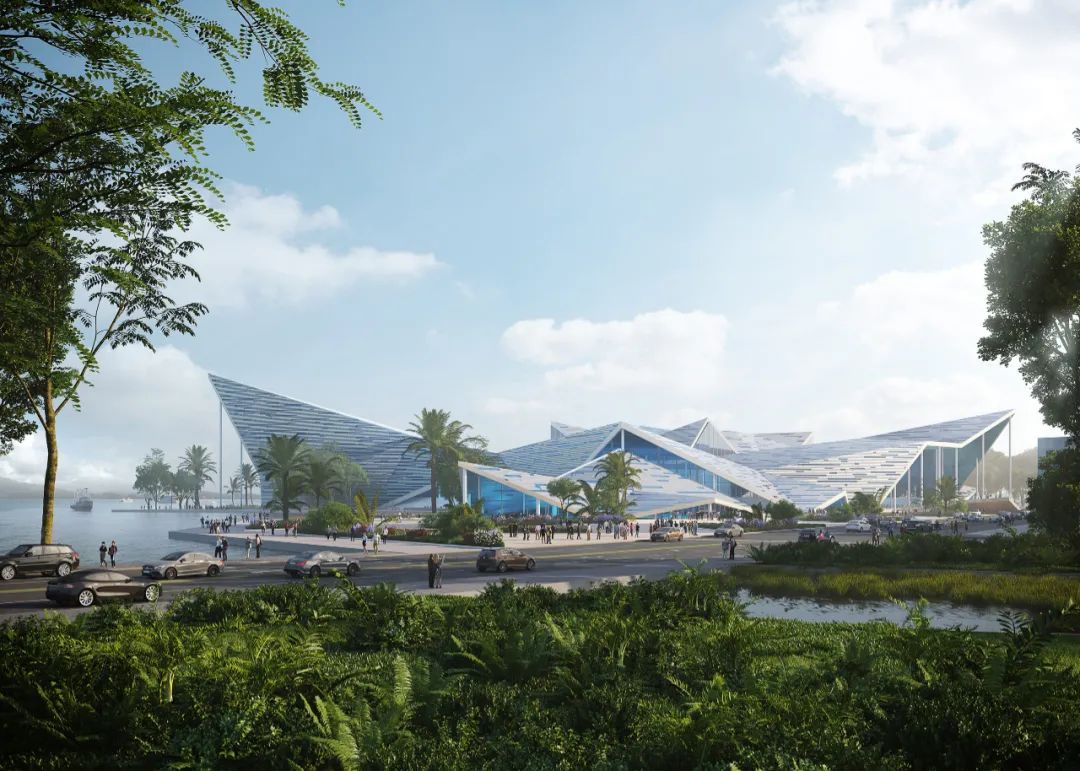
在主场馆之外,歌剧院还包括3个辅助结构。望海路以北有两座建筑,内设演员公寓、舞台设计办公室和一个制作中心。主建筑旁,在场地的东北侧,是一座艺术厅。每一座附属建筑都设计了折叠式的屋顶,保证了与主剧场一致的建筑语言。
Outside of the main opera house, the project also includes 3 ancillary structures. Two buildings to the north of Wanghai Road contain apartments for the performers and offices for stage design and a production centre. Alongside the main building, on the north-east side of the site, is an art foyer building. Each of these additional structures is completed with a folding roof to give the same visual language as the main building.
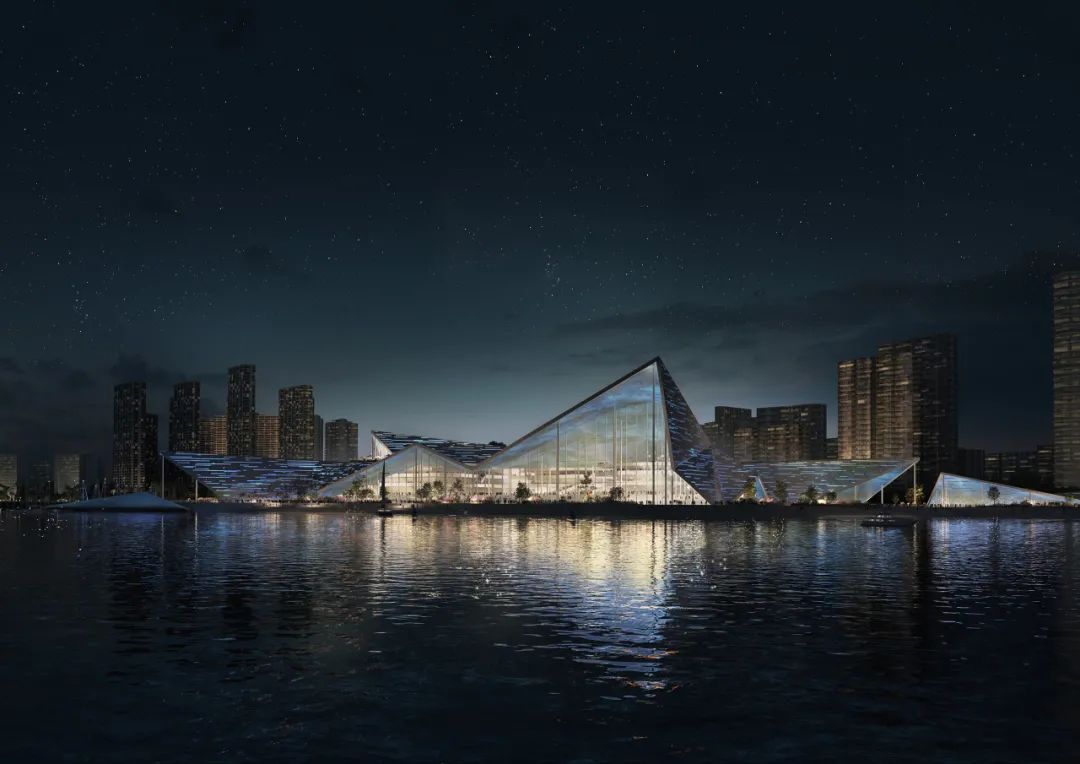
MVRDV充分考虑了散布于各单体建筑之间的景观,以提升歌剧院的公共功能,吸引更多的人们来此聚集和停留。景观设计结合了深圳的本地植物、水景和活动空间,并用一条长廊环抱整座建筑,人们可以通往这条长廊到达海边和角落里的一处码头。景观元素和倾斜屋顶采用的大面积光伏板极大地推进了建筑的可持续发展目标。
In the spaces between, the project’s landscaping has been carefully considered to improve the public functions of the building and give people more reasons to visit and stay. The landscaping incorporates native plants, water features, and event spaces, while a promenade wraps around the entire building to give access to the waterfront, including a pier on one corner of the site. These landscape features contribute greatly to the building’s sustainable ambitions, which are further helped by large areas of photovoltaic panels that are included in the sloping roofs.
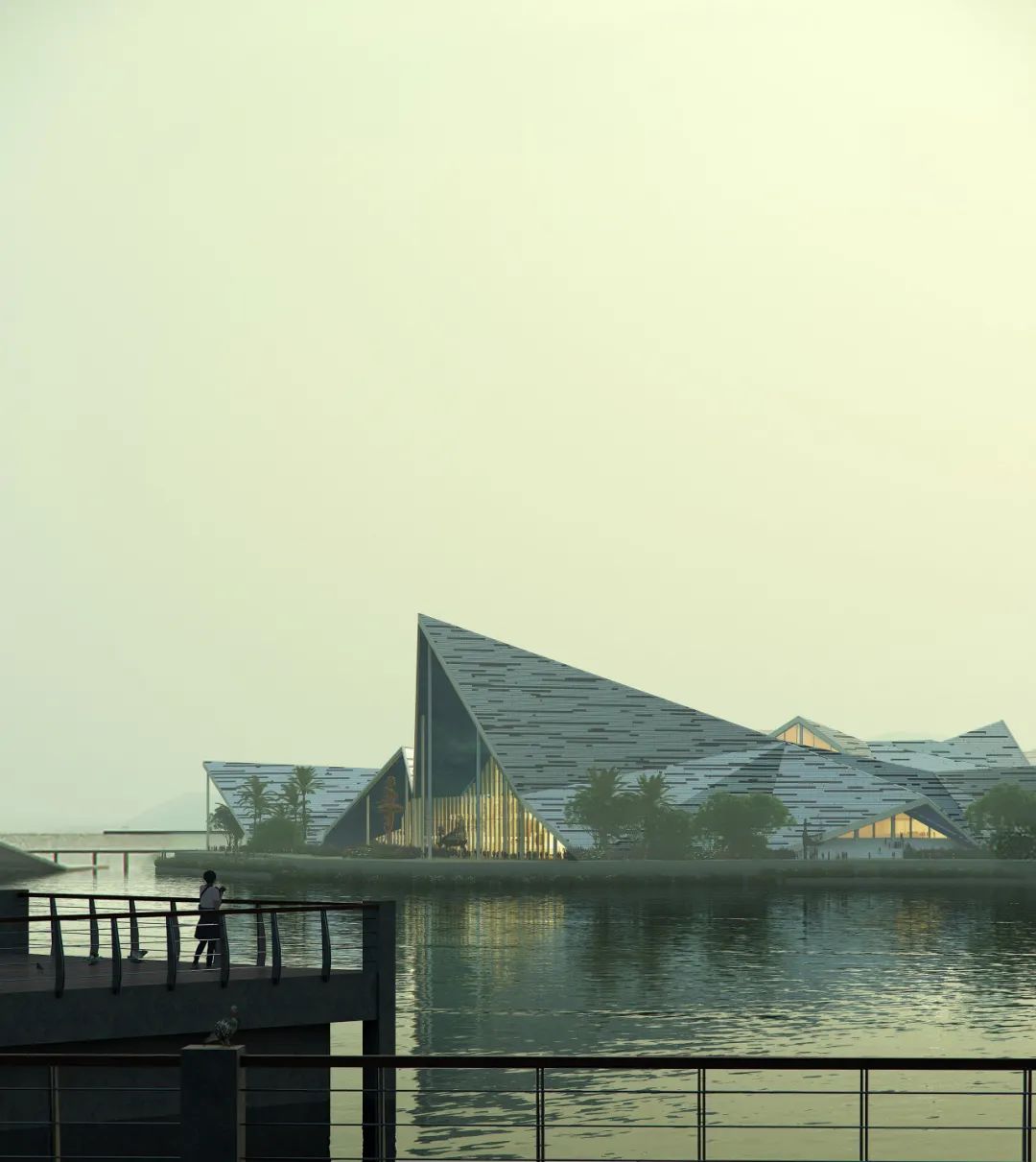
合作伙伴:
联合体单位:广州市设计院
剧院顾问:伦敦 Theatre Project
结构顾问:上海奥雅纳
效果图/视频:Atchain
Partners:
Co-architect: Guangzhou Design Institute
Theatre consultant: Theatre projects, London
Structural engineer: Arup Shanghai
Video and renderings: Atchain
特别声明
本文为自媒体、作者等档案号在建筑档案上传并发布,仅代表作者观点,不代表建筑档案的观点或立场,建筑档案仅提供信息发布平台。
17
好文章需要你的鼓励

 参与评论
参与评论
请回复有价值的信息,无意义的评论将很快被删除,账号将被禁止发言。
 评论区
评论区